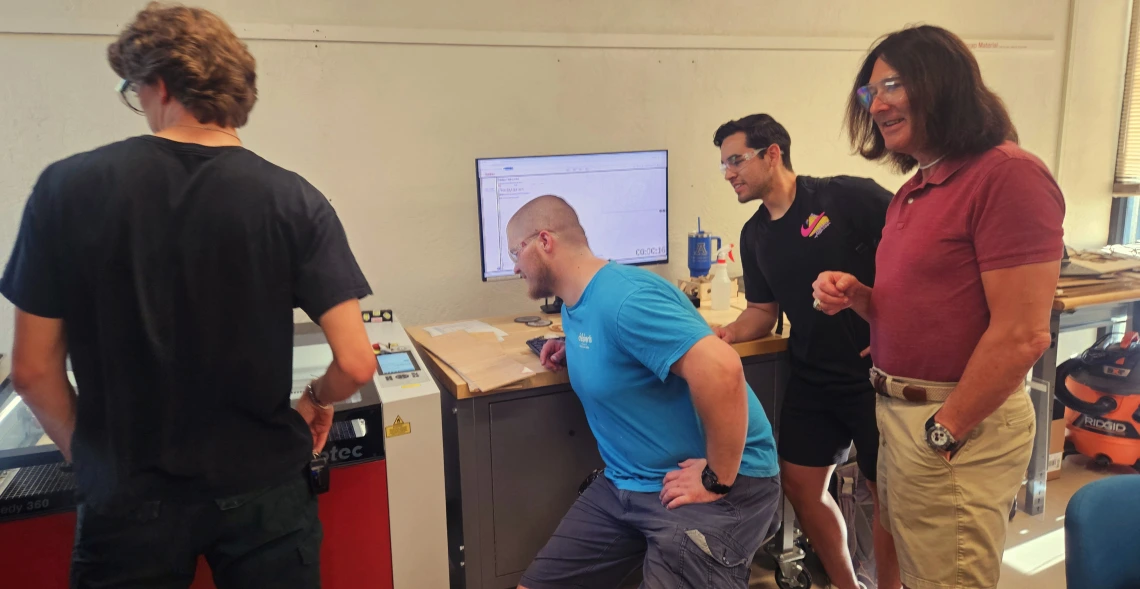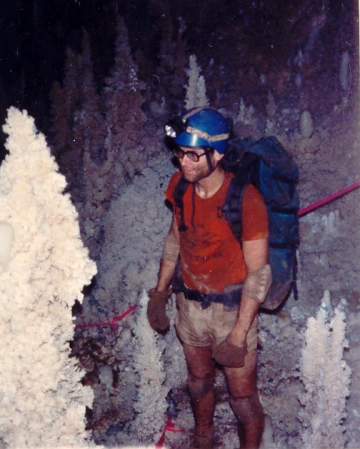One-on-one with mentor Bert Schneider

Bert Schneider (right) works with a capstone team in the Engineering Design Center.
Bert Schneider has enjoyed two successful careers – as an officer in the U.S. Air Force and with Raytheon, an RTX Business. Over 40 years, he built expertise in areas including technical leadership, research and development, facility management, systems engineering, technical marketing, consulting and financial planning.
Schneider earned bachelor’s and master’s degrees in electrical engineering from Virginia Military Institute and the Air Force Institute of Technology, respectively. He also completed an MBA at the University of Arizona Eller College of Management. After retiring from Raytheon in 2021, Schneider became a panel member for Interdisciplinary Capstone design reviews, then a judge at Craig M. Berge Design Day. He joined the program in January as its newest mentor.
What inspired you to become a mentor?
I taught at community colleges, and I served as an assistant professor of aeronautics and was the aeronautics laboratory director at the United States Air Force Academy. I have always felt I should help and pass on my knowledge, skills and experiences to others so they can better themselves.
When my children were in grade school, I volunteered to help their teachers administer SAE International’s A World in Motion program, which gets children excited to pursue STEM careers and helps broaden career access. At Raytheon, I led the Cadet Summer Research Program, which invites cadets from military academies to spend summers working on projects and learning about the defense business from the contractor's side.
How does being in a mentored design team help students in the professional world?
I tell my students that they are going to be light years ahead of their peers after they graduate. The capstone program provides so much more depth and exposure to what it is like to work in industry than just doing academic exercises. They get experience in team building, communicating, planning, budgeting, organizing, documenting, coordinating, working with other disciplines, and giving presentations. They also work for a real customer and have their efforts evaluated by a panel of professionals during design reviews.
Potential employers not only get an outstanding engineer but a solid individual who is a team player, a contributor, a problem solver, and a leader.
Describe an aha! moment with a team.
I’m guiding a team designing a better instrument for dental hygienists and dentists. Workers using the current tools can experience symptoms of carpal tunnel syndrome. I was concerned about how this team was going to get the full Engineering 498 experience with a limited scope of work. The team was unsure how to create the artifacts the course requires, such as functional flow block diagrams and architectures. We brainstormed and came up with three ideas:
- Conduct a survey of dental health professionals asking about the limitations of existing tools and incidence of CTS symptoms.
- Measure the amount of strain and muscle flexure users experience with existing instruments and with the team's newly designed tools.
- Determine the cost and benefit of creating a new tool intended to reduce muscle strain.
The students knocked it out of the ballpark at preliminary design review. Their presentation was one of the best I have ever seen. I was blown away by this team's ingenuity.
What advice would you offer to others considering mentoring a design team?
Mentoring is not your typical teaching assignment. It’s more about giving students a glimpse of how to be successful not only at a job, but in life. If you have a knack for sharing experiences, telling war stories, and translating geek language to help that lightbulb come on in a student's head, then this is a neat experience for you!

Bert Schneider takes part in a caving expedition at New Mexico’s Lechuguilla Cave in the early 1990s.
Tell us more about you.
My lovely wife, Peggy, and I have been married for 43 years. Our two children earned bachelor’s degrees at the U of A, then went on to complete doctoral degrees elsewhere. We also have two grandchildren we love.
One of my challenges is that I have many interests and hobbies, including board games. Through playing historical war games, I’ve become friends with rock star Cory Wells of Three Dog Night.
I portray Darth Vader with the 501st Legion. Our group, a worldwide costuming organization operated by Star Wars fans, visits children's hospitals and participates in charity events and community activities.
Finally, I feel grateful to be alive. I had cancer surgery 20 years ago. Two months after my father passed away from prostate cancer, I was diagnosed with the same cancer. Going through this scare and the worst year of my life gave me a healthy appreciation for life and all the people I meet. I’m aware there are much bigger fish to fry than living a lifestyle focused around climbing a corporate ladder.

